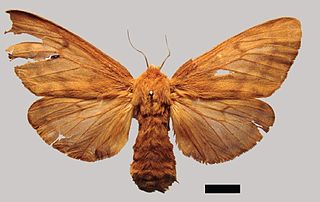Phoberomys is an extinct genus of rodents. Fossil specimens from the Late Miocene period have been discovered in the Ituzaingó Formation of Argentina, the Solimões Formation of Brazil, the Urumaco Formation at Urumaco in Venezuela, and the Pliocene of Peru.

Mantoida is a genus of praying mantises in the family Mantoididae. The species of this genus are native to Mexico, Central America, and South America.

Brontornis is an extinct genus of giant bird that inhabited Argentina during the Early to Middle Miocene. Its taxonomic position is highly controversial, with authors alternatively considering it to be a cariamiform, typically a phorusrhacid or an anserimorph.

Phyllomedusa burmeisteri, also known as Burmeister's leaf frog and common walking leaf frog, is a species of frog native to the Atlantic Forest biome in Brazil.

The slender-tailed woodstar is a species of hummingbird in tribe Mellisugini of subfamily Trochilinae, the "bee hummingbirds". It is the only species placed in the genus Microstilbon. It is found in Argentina and Bolivia.

The black-legged seriema is one of two living species of seriemas in the family Cariamidae. It is found from southeastern Bolivia and northern Paraguay south into north-central Argentina. It is a large, mostly grey bird with a long neck, a long tail, and long, slender black legs. Its belly, vent and thighs are yellowish-white. The sexes look similar, as do immature birds, though the latter are more patterned on head, neck and back. First described for science by Gustav Hartlaub in 1860, it is monotypic, with no subspecies. Like its red-legged cousin, it is an omnivore. It seldom flies, instead pursuing prey and eluding danger on foot. Its loud calls, said to sound like kookaburras, turkeys or yelping dogs, are often given in duet. Little is known about its breeding ecology. It is known to breed in November and December, building a platform nest of sticks and laying two white eggs, which are sometimes marked with a few brownish or purple spots. The International Union for Conservation of Nature rates the species as one of least concern, due to its large range and apparently stable numbers.

The rough-legged tyrannulet is a species of bird in the family Tyrannidae. It is found in Argentina, Bolivia, Brazil, and Paraguay. Its natural habitats are subtropical or tropical moist lowland forest and subtropical or tropical moist montane forest. The white-fronted tyrannulet was formerly considered a subspecies.

Gastornithiformes were an extinct order of giant flightless fowl with fossils found in North America, Eurasia, and possibly Australia. Members of Gastornithidae were long considered to be a part of the order Gruiformes. However, the traditional concept of Gruiformes has since been shown to be an unnatural grouping.

Chaeteessa is a genus of mantis. It is the only extant member of the family Chaeteessidae, the most primitive lineage of living mantises. It contains six species found in South America:

Pelidnota virescens is a species of beetle of the family Scarabaeidae.

Paracles burmeisteri is a moth of the subfamily Arctiinae first described by Berg in 1877. It is found in Argentina.

Pelidnota is a genus of beetles of the family Scarabaeidae.
Chaeteessa burmeisteri is a species of praying mantis in the family Chaeteessidae.

Pelidnota kirbyi is a species of beetles of the family Scarabaeidae.
Rutelini is a tribe of shining leaf chafers in the family Scarabaeidae. There are about 14 genera and at least 40 described species in Rutelini.
Ozophora burmeisteri is a species of dirt-colored seed bug in the family Rhyparochromidae. It is found in Central America and North America.
Labops burmeisteri is a species of plant bug in the family Miridae. It is found in Europe and Northern Asia and North America.
Hebrus burmeisteri is a species of velvet water bug in the family Hebridae. It is found in Central America and North America.
Phoberomys burmeisteri is an extinct rodent that lived in the late Miocene of southern South America. It lived in wetland environments, such as swamps and marshes, where it likely fed on aquatic plants and grasses. It was first described in 1884 by the German zoologist Hermann Burmeister, who named the species after himself. Their remains were recovered from the Ituzaingó Formation in Entre Ríos Province, Argentina.
Canopus is a genus of Neotropical bugs with about six species that form the family Canopidae. Bugs in the family Canopidae are small and have a convex lady-bird beetle like shape and are thought to be fungus feeders. The scutellum completely covers the abdomen and wings. The antennae are five segmented.












